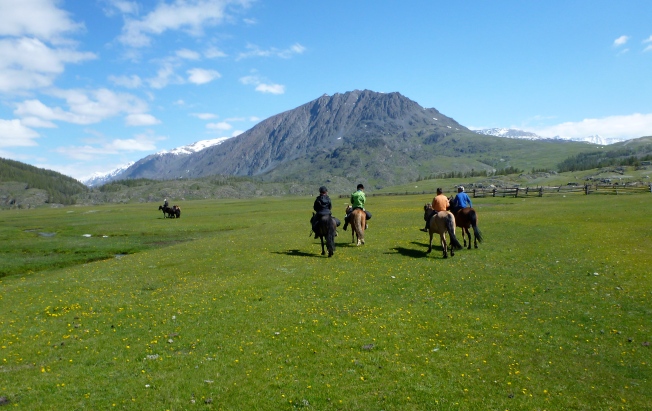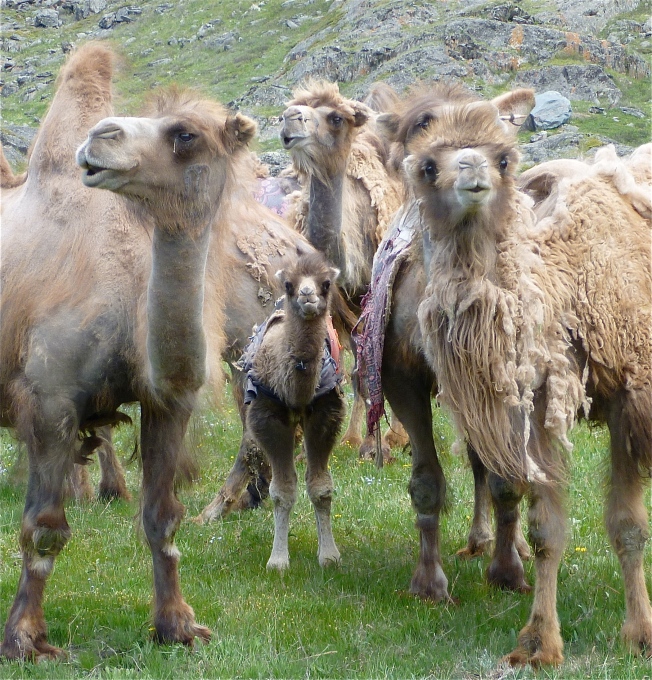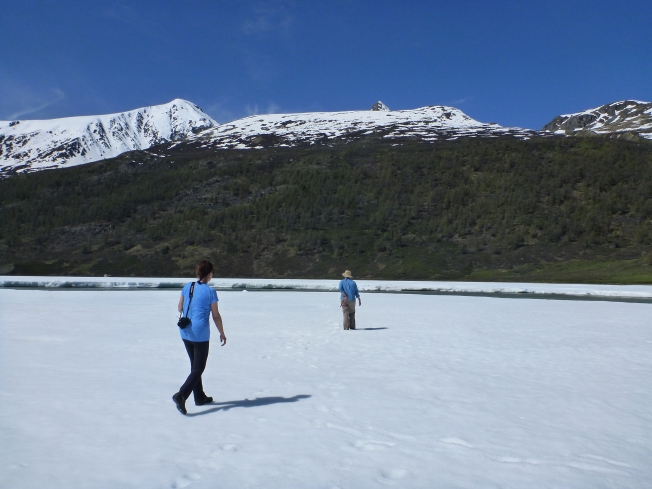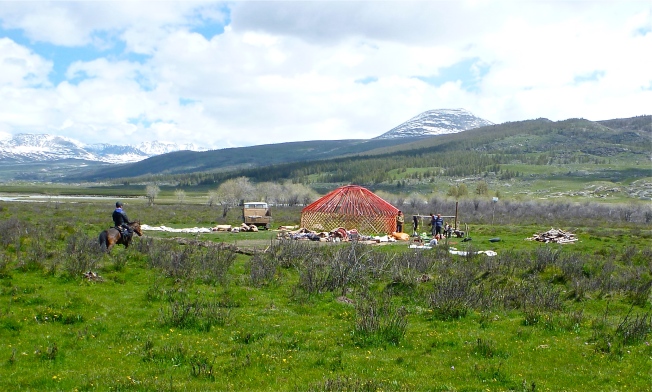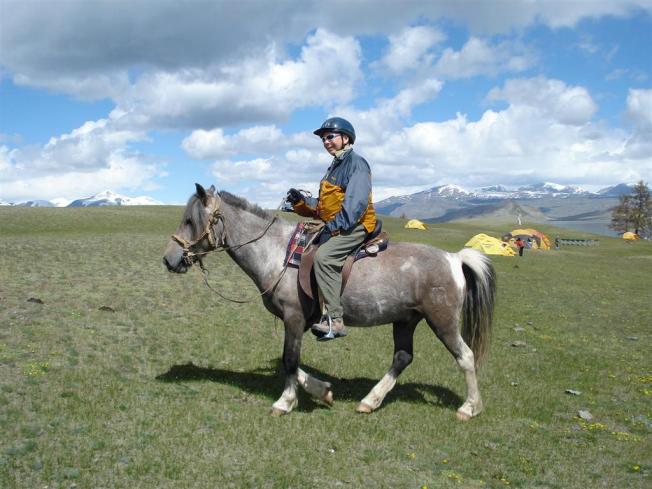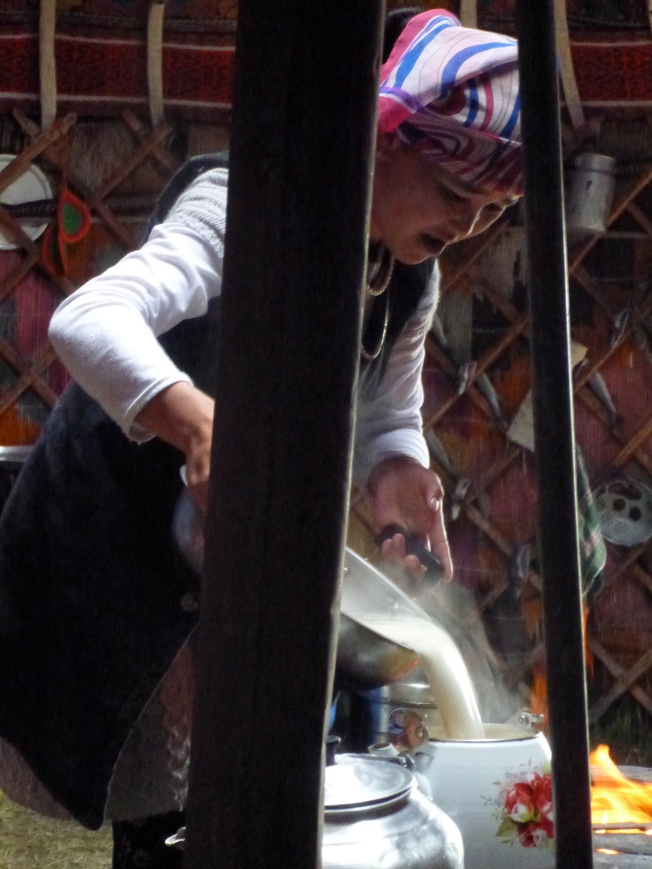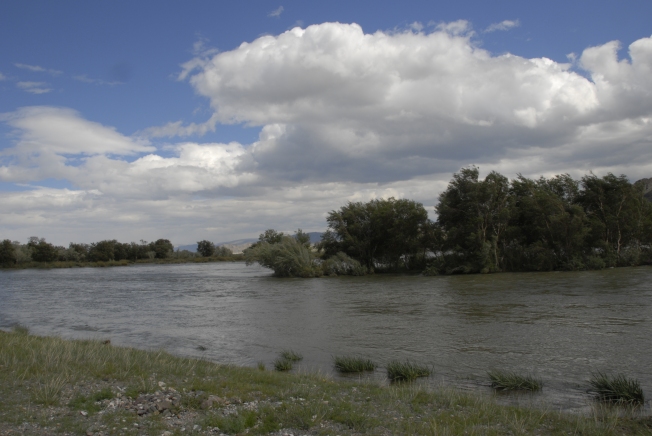RETREAT
CAMP FIVE: June 18
Cloudy skies, cool wind and occasional light rain were perfect for retracing our steps down the valley, as hot sun would have exhausted us. The descent over the rocky hills was long, steep and occasionally difficult. We came to one especially daunting drop, and Tom, who was riding today, stopped, unsure how to proceed. At Amy’s urging I kicked Breeze forward, planning to take a rock ramp to my right. Breeze decided to take the direct route and jumped straight down to a sloping ledge, landing sure footed as always but giving me quite a fright. Tom’s horse showed more sense and took the ramp.
As we neared camp, two teenagers from our kitchen staff galloped up behind Karyn and gave a loud shout, a trick they often play on each other. Karyn, of course, wasn’t prepared, and her horse bolted, throwing her off. She came away with bruises and a sore ankle, which probably were less severe than the lambasting the boys could look forward to from Dosjan. They seemed so stricken the next day that Karyn went out of her way to reassure them that she wasn’t angry.
We haven’t returned to Cheben Hill but rather have a lovely site in a meadow by a stream, with snow-capped mountains as a backrop. I climb a hill behind camp for the view and find red-stemmed saxifrage and telesonix in bloom. Later, Alex brings out popcorn, and those who haven’t collapsed in their tents munch and natter until vodka time.
CAMP SIX – UPPER KHOTAN NUR: June 19
Storms threaten all day, but our ride is easy over grassy hills, across bridges and streams, past herds of sheep and goats. We lunch by a bridge and get to watch our camels and crew come across.
Alex is with them, tall astride his little horse, the ever-present wide grin on his face.
The river is the local car wash.
We enjoy some late-day sun in camp. Sheep and goats from a near-by ger wander in, their gentle voices a reminder of all that I will miss once I return to Canada.
Eddie brings out his martini bar.
And a group photo is required.
Eric and the wranglers produce a roaring bonfire after dinner, and we sit around it, saying little, thinking. Tomorrow will be our last day on horse.
LOWER KHOTAN NUR: June 20
Soft grey light on dark water. Mist on the hills. A gentle rain. Plaintive cries of sheep and goats. Warblers among the larches. The dull clip-clop of horse hooves on wet grass. For a few hours we are enveloped in beauty, and I give myself over to the poetry and magic of the place. Can this really be the last time that I will come here? There are moments when I wish I could reach out and stop the hands of time.
We come to a river that is deep and fast, raging from snowmelt and rain. “Put just the toes of your boots in the stirrups, so you can get off if the horse falls over.” It takes a lot to frighten me, but I am full of trepidation as I search downstream for something to grab on to in case I am swept away from Breeze. The horses struggle in the strong current, and for a lifetime it seems that we are all being pushed sideways, making no forward progress. There’s no way to completely banish the rushing water from the field of vision, and I fight vertigo. Then Breeze finds firm footing, masters the current, and we lunge up the river bank.
Now the rain falls heavy and steady. We decide to delay lunch until we arrive at Karbai’s ger, not far now. As I start up the final hill, two locals on horseback come down through trees on my right. Breeze shies and I calm him. The riders pass behind, and I assume they will continue on down the slope. Instead they turn, gallop up behind me and shout, just as the young boys did to Karyn. Breeze jumps and bolts, and only blind luck keeps me in the saddle. I’m furious, but Eddie just says that this is what the locals do, and you have to be prepared. He’s right, of course.
FAREWELLS
Next morning we bid good bye to our wranglers and crew with many hugs and a few tears, then board the Land Cruisers for the return to Ulgii. Dosjan leads us on a spectacular shortcut through the mountains and over a pass, giving us a final chance to appreciate the haunting beauty of this country.
We stop briefly in Sagsai to see a hunting eagle. Hunting with eagles is still widely practiced in winter, and even though we hated to see this noble bird confined, we wanted to interact with it.
After tea and treats with the master’s family, we drive to our dismal camp in Ulgii. The gers have been properly furnished and decorated by now, but the caretaker is as clueless as ever, and breakfast is still stale bread and over-cooked eggs.
At 0430 our ger door flies open and we awaken to “Hooh!” By 0730 we have checked in at the airport. Ominously, all the locals who checked in have gone home. We sit until 1530 on hard chairs, eating Mongolian dumplings, greasy fritters and western junk food until the plane finally arrives.
The farewell dinner in UB, that was scheduled for tonight, gets put off to tomorrow. I finally reach my room at the Bayangol at 2100, grab a Heinekin from the mini bar, order a superburger and fries from room service, and reflect on how glorious trips sometimes end in a whimper.
REFLECTIONS
What do I take from this second venture in Mongolia? I feel as much at home here as in the far north of Canada. Indeed, Canadians and Australians are perhaps the people best able to relate to these vast, empty lands, for such lands comprise and define each of our countries. Much of what I love about Mongolia I can find in Canada: vistas that seem to go on forever, wind that blows unhindered by any tree, the great blue dome of sky, silence, solitude. But only here have I found a people of such unequaled hospitality, quick to smile, eager to help and share. Add to them the courageous little horses, so willing and sure footed; the herds grazing peacefully, tended on horseback by nomads as they have been for centuries; the gers, those marvels of engineering, where doors are never locked and strangers never turned away; the quiet rhythm of a life centred around livestock and the home, where pleasures are simple and tradition still means something.
I know that Mongolia is changing. Perhaps this snapshot that I take away will soon be as outdated as last year’s computer. I have devoted much of my life to travel and adventure. Always I learn and always I am enriched, but only rarely does the experience touch my innermost being. Mongolia, as I see it today, will always be a part of me.






















